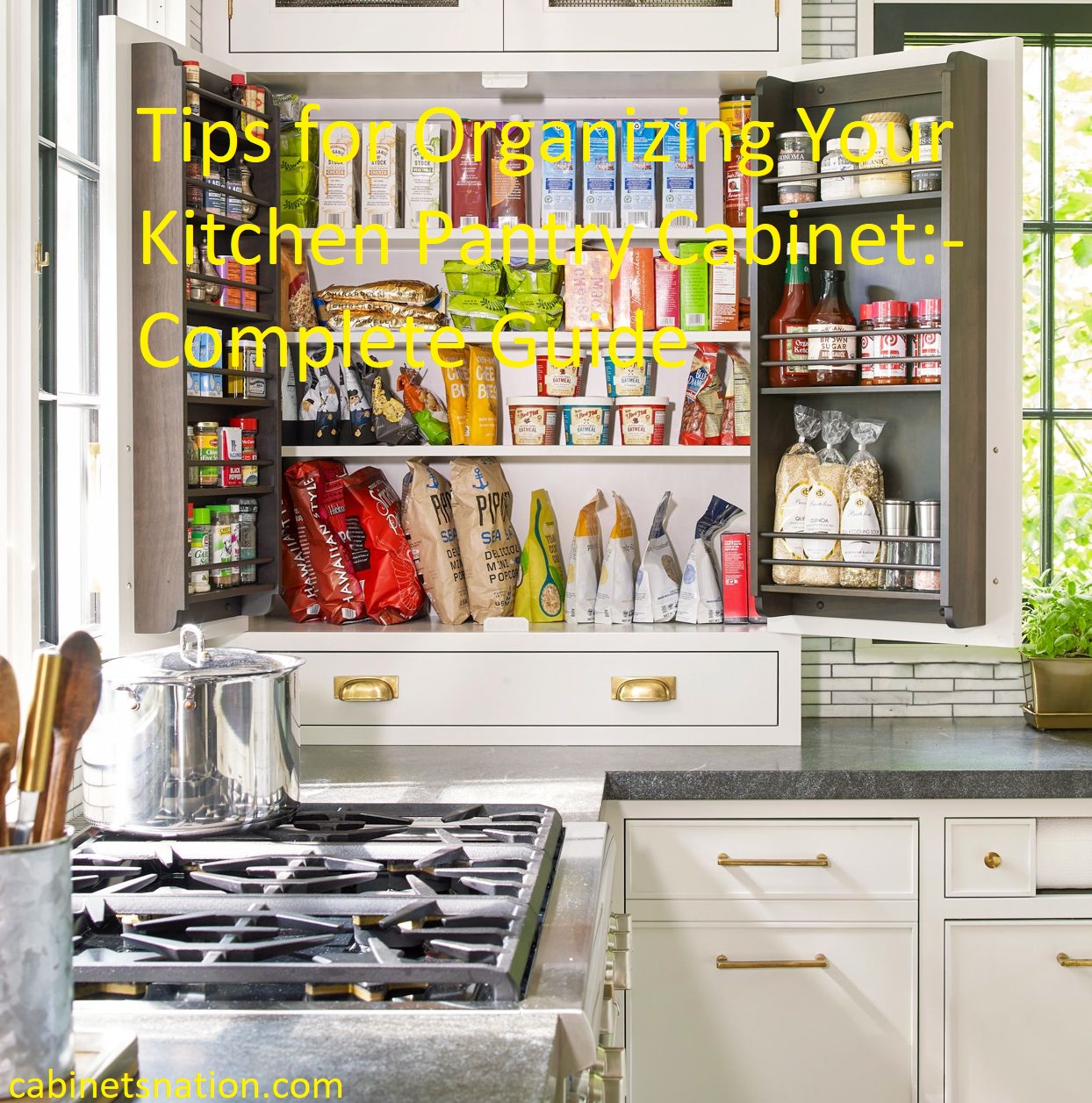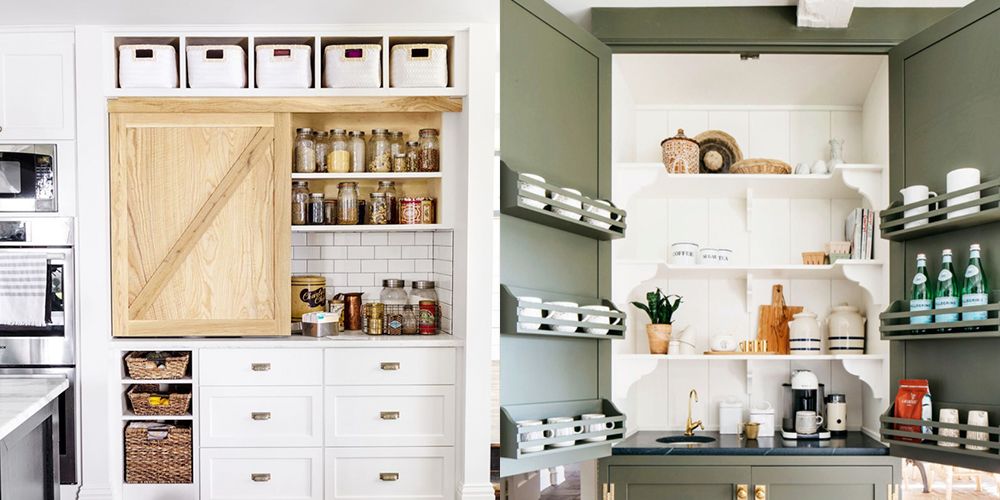Do you dread the sight of your chaotic kitchen pantry? Say no more!
This complete guide will help you tackle the task of organizing and maximizing your kitchen pantry cabinet. You’ll be amazed at how efficient your kitchen can be!
Are you feeling overwhelmed by your pantry cabinet but feel like you don’t have enough room to store your food and kitchen supplies? Pantry cabinets are a convenient place to keep all of your cooking ingredients, supplies, and snacks so that you can quickly find what you need for meal prepping.
To help make your pantry cabinet organized and efficient, we’ve compiled a list of tips to help get you started on organizing your pantry cabinet and maximizing space. For each tip, we’ve included detailed explanations so that you can easily implement these strategies in your own home.
So let’s dive in and get started!
Assessing Your Pantry Cabinet
Before you begin rearranging your pantry space, it’s important to figure out exactly how much room you need. Begin by assessing and measuring the area where you plan to store your items. Make sure to measure the interior shelving and ceiling heights of both open shelves and cabinets so you can calculate how much space will be available for storage. It is also helpful to take note of any awkward angles or narrow spaces that may have difficulty storing certain items.
Once you have measured your kitchen pantry cabinet, take a few moments to gather all of the perishable items together in one place before transferring them into other closets or cabinets. This will help ensure that nothing gets forgotten during the organizing process. Once everything is collected, organize it into groups according to type, as this will make it easier for you when deciding which areas are best suited for what types of items.
Once sorted, create a list of all of your kitchen pantry categories with their corresponding measurements so that you can easily refer back to it when shopping for new perishable items in the future.
Determine the size and shape of your pantry cabinet
The size and shape of your pantry cabinet will determine how you organize it. Measure the interior of the cabinet and make a list of items to be stored. This will help you plan for any shelves, dividers or baskets to be included in the pantry. Before you begin organizing, survey the space and find out what storage solutions fit best.
Choose storage containers that are stackable, so you can get more out of your cabinets without crowding them with too many containers. Also, look for storage solutions that can help you visually organize items so you can easily find what you’re looking for in your pantry without pulling everything out. If possible, use clear plastic containers or bins with labels so that items are easy to spot when needed.
Organization should follow functional needs as well as aesthetic value. Your pantry should be a reflection of your lifestyle so that it grows with you and meets your needs now and in the future. Don’t forget to also account for any bulky appliances or tools which may require additional room or could need careful packing on shelves away from food supplies!
Take inventory of what you have and what you need
Before you start organizing your kitchen pantry, it’s important to determine what you have and what you need. Taking inventory makes the task of organizing more efficient and prevents overbuying. Check both the expiration dates of canned goods and staples like flour, sugar, oils, and spices. Discard anything that is past its expiration date or do not plan to use up in a timely manner.
Think about optimal storage for each item in your pantry as you take inventory. You may decide to keep most items on shelves but store canned goods in a basket or bin so that they don’t roll off shelves when your pantry door is opened or closed quickly. Consider investing in plastic containers with lids to keep foods fresh and bugs out, such as rice, cereal, nuts, baking ingredients, dried fruit, etc.. Having containers of similar shapes and sizes can create uniformity while organizing which can improve how visually appealing the pantry looks after completing this task.
Clearing Out and Cleaning Your Pantry Cabinet
The first step to reorganizing your pantry cabinet is clearing it out. This gives you a chance to get rid of expired or stale food, throw out items you won’t use, and do a thorough cleaning of the cabinet itself.
When clearing out your pantry, make sure to remove all items from the shelves and sort them into categories. It can help to have a few boxes or containers handy so that you can easily separate things into “trash,” “donate” and “store.” Additionally, check expiration dates on any food items to make sure they are still good before storing them back in the cabinet. Once everything is sorted, sweep and mop out the cabinet before placing anything back inside.
For digging deeper into cleaning your kitchen pantry cabinet, pour some disinfectant or an all-purpose cleaner in a bucket filled with warm water. Be sure to take out all the shelves from the cabinet so you can use your cloths and mop heads for proper cleaning and sanitization. Start scrubbing away at any sticky residue or dirt on the interior walls of the cabinet as well as on shelving racks that were removed earlier from it. Once satisfied with its cleanliness level, take dry paper towels (or microfiber cloths) to dry off all surfaces both inside and outside of the pantry cabinet for a spotless look!
Remove all items from your pantry cabinet
Undertaking the task of organizing your pantry cabinet can be daunting, but having an organized pantry makes finding the items you need quicker and easier. A clear and clean storage area also shelves ensure that food items are stored properly.
Before you start to organize your pantry cabinet, it is important to begin with an empty space. Take out all the items that are currently stored in the cabinet and place them on an easily accessible surface like the countertop or a large table covered with newspaper or a plastic tablecloth. Going through all the items will help you create categories within your pantry cabinet for different types of foodstuffs, such as canned goods, spices, baking supplies, etc. It will also help you identify which foods may have reached their expiration date or gone bad so that they can be discarded if necessary. This step is also important if you plan on giving away unopened goods to friends or family members who may benefit from them more than you would at this time.
Clean and sanitize your pantry cabinet
Before organizing any space, it’s important to clean and sanitize the area. Clean the shelves, insides, and outside of the cabinet with a multi-purpose cleaner. Then make sure to dry it off with a microfiber cloth. Taking this extra step will help ensure that everything placed into your pantry is as sanitary as possible and free from germs or bacteria.
Choose a sanitizer that is safe for kitchen surfaces and is not too harsh on your cabinetry or shelves.
Organizing Your Pantry Cabinet
Organizing your kitchen pantry cabinet can be a daunting task, but with the right tools, techniques and strategies in place, you can create an efficient and attractive storage space. Here are some tips to help you organize your pantry cabinet:
- Make it easier to find what you need by grouping items together on shelves or in drawers. Label containers for each type of food, such as canned goods, boxed foods, and snacks.
- Use wire baskets to store loose items such as fruits, vegetables, and snacks. There are also collapsible shelves that make it easier to stack items of various shapes and sizes.
- Utilize door storage for hanging coffee mugs and other items that don’t fit well on shelves or in drawers
- Use adjustable bins to organize non-edible items such as napkins, paper towels and cleaning supplies
- Place frequently used items close at hand – either at eye level or within easy reach
- Utilize wall space with ready-made racks for spices or movable hooks for soap squeegees
- When possible designate a spot for everyday essentials such as spices or baking ingredients
- For added convenience use slide-out trays or rotatable carousels so that all sides of your pantry can easily be seen.
Categorize your items
Organizing your kitchen pantry cabinet is the first step towards making it more efficient and easy to use. The goal of organization is to make sure that you can quickly locate whatever you need in a matter of seconds, instead of taking an eternity to find the items that are hidden behind stacks of dishes or cans. It can be a difficult task but with proper planning, it can yield tremendous results. Here are some tips to help you get started:
Categorize Your Items – Once you’ve gone through everything, start grouping like items together. Think about how often you use each item and how easy it would be to access when needed. Typically, a combination of tall shelves and some drawers or bins would work great for categorizing items according to their purpose – this will make them easier to locate when needed. Create categories like “canned goods,” or “cooking utensils,” and put each item where it belongs accordingly.
Label Your Shelves – You should also label your shelves so that other family members know where certain things belong as well as quickly find what they’re looking for when they need something from the pantry. This allows everyone in the family an easier time navigating the space and keeping it organized as much as possible for everyone’s benefit!
Choose storage containers and organizers
Finding the right storage containers and organizers can make a big impact on how efficient and organized your pantry is. Consider adding spice racks, produce bins, adjustable shelves and dividers to help you store items neatly and maximize your space while keeping everything easily accessible.
Choose airtight containers to ensure long-lasting freshness of items stored in them. You can also look for stackable containers that are versatile enough to hold any size item or food product. Finally, label all of your containers with the contents inside so that you can find items quickly when you need them.
Having organization tools at your disposal will help you create an efficient kitchen pantry cabinet!
Maintaining Your Organized Pantry Cabinet
Maintaining your pantry cabinet’s organization doesn’t have to be a daunting task. With just a few simple strategies, you can keep things neat and tidy while making sure that all of your food items are properly and safely stored. Below are some tips for ensuring that your pantry remains in perfect order.
- Make a habit of regularly rotating items so that the oldest items are being used first. This can help prevent spoiled or expired food from accumulating to the point where it becomes difficult to locate or store new items.
- Place slippery or hard-to-stack containers inside baskets, bins, or larger containers that have labeled lids for easy identifications down the line. This will help you save time by not having to dig through piles of packaged goods when you need something specific.
- Try to use transparent food storage containers so that you can easily identify what is inside each one without having to rummage through them all.
- Place big and bulky things on lower shelves so they’re easier to access and less likely to get lost behind smaller items tucked away on higher shelves.
- Utilize door storage organizers with pockets and racks for easy storage of snacks, spices, condiments, and other smaller kitchen necessities like measuring spoons and spatulas so they aren’t taking up valuable shelf space elsewhere in your pantry cabinet.
- Hang small pockets onto the side of your pantry if viable with coupons or recipe cards for quick reference when needed.
- Employ shelf risers on shelves lower down if there isn’t enough headroom between each row of food packaging or cans; this will also make regular routine inspection easier as everything will be visible without having bend down too low repeatedly while scanning what’s currently stored on each one of them periodical check in process visuallyable more easily referingminimazing back pain esseningly.

Regularly check for expired items
Organizing your kitchen pantry cabinet is essential for streamlining the storage of food products and ingredients. Checking regularly for items that have passed their expiration date is a key component and should happen at least twice a year. This will ensure not only more efficient use of the items in the pantry, but also help to ensure that what you are consuming is safe and of good quality.
Expired items typically accumulate at the back or in hard-to-reach places, so taking the time to check all parts of the pantry thoroughly is important. You may choose to do this in one big push or space it out over several days. Check each item’s expiry date before returning it to its appropriate spot. With non-perishable items like grains, cereals and canned foods, it is best to replace them as soon as they cross their expiration date – they can become harder or bolder in texture as they age and becoming prone to contamination by pests such as mice. With perishable foods like nuts, seeds and spices, if stored properly these can last significantly longer than their expiration dates suggest but these should still be checked for signs of spoilage before consuming them.
Organization goes beyond simply making sure all expired items are discarded – ensuring that labels are visible, organizing things alphabetically or by category being key steps towards more efficient storage. Making use of extra space such as stacking containers vertically where possible gives you added storage capacity when on shelves and makes sure everything stays within easy reach when needed. If you have room for drawers or bins within your kitchen pantry cabinet these can be useful places to sort spice packets and other small loose items which might otherwise get easily lost or forgotten about buried at the bottom somewhere. It will also make future sorting sessions much easier!
Clean your pantry cabinet regularly
One of the most important steps in keeping your kitchen pantry cabinet organized is cleaning it on a regular basis. A clean pantry will limit the spread of germs and allergens and help you to better assess the items in your cabinet.
Start by taking everything out of your pantry and discarding any food or kitchen items that may have expired or gone bad. Wipe down the shelves with an appropriate cleaning solution, and if you see any spots that are especially dirty, use a scrub brush for extra cleaning power. Be sure to look for any signs of pests or roaches – if you find anything, don’t forget to call an exterminator.
Finally, wash off all containers before putting them back into your pantry shelf.
Conclusion
Finally, it is recommended to review your pantry cabinet organization at least once a year. This helps to ensure that you are making the most of the space available, and that all items are neat, safe and accessible. Investing in a few storage containers and reorganizing items in your kitchen can make everyday tasks like cooking easier and can help increase storage potential.
Taking the time to develop an effective system for organizing your space will save you time in the long run, freeing up more of your valuable time to spend on things that really matter.
With these tips for organizing your pantry cabinet, you can organize an effective and efficient kitchen for cooking with ease!
FAQ’s
In what order should a pantry be organized?
The best order for organizing a pantry is to start by taking everything out and sorting it by item type (canned goods, spices, baking supplies, etc.). This allows you to easily locate similar items and group them together. Next, you should set up shelves or baskets to separate and organize each item type. Finally, label containers clearly and group similar items together within each type for easy access.
How do I organize my kitchen pantry categories?
Organize kitchen pantry categories in a way that makes sense and is easy for you to maintain. Consider grouping items by type (e.g., canned goods, snacks, condiments, etc.), by frequency of use (e.g., everyday items, occasional items, etc.), or by expiration date (for instance, putting perishable items in the front).
How do I layout my pantry?
Answer:Organize your pantry by grouping similar items together (e.g. canned goods, baking supplies, snacks, etc.), placing frequently used items at eye level, and storing heavier items on bottom shelves. Utilize vertical space with shelves or baskets, and consider using clear storage containers and dividers. Use labels to categorize items to help you locate items quickly.
How do you manage a kitchen pantry?
Managing a kitchen pantry requires organizing items based on type and frequency of use, researching and stocking up on staple items that are typically used, rotating items and using items in a timely manner to prevent spoilage and expiration, and ensuring the pantry is well-stocked with healthy and nutritious food items.
What is the rule of pantry?
The rule of the pantry is that all food items should be labeled with the owner’s name, and all food should be consumed in moderation.
How does Marie Kondo organize pantry?
Marie Kondo recommends organizing the pantry by group, such as storing all the dry goods together, pantry staples together, and condiments together. Items should be stored in transparent containers so it is easy to view the contents. Labeled containers can also help to quickly identify exactly what is inside.
How does Martha Stewart organize a pantry?
Martha Stewart recommends organizing a pantry by groupings, such as spices and condiments, packaged goods, baking supplies, snacks, drinks, and so on. She recommends putting similar items together and allocating specific spots for them. Additionally, Martha suggests using shallow baskets, bins, jars, shelves, and containers for storing items, as well as labelling them to keep pantry contents visible, neat, and organized.
How do I organize my pantry bulk items?
Organize bulk pantry items by grouping like items together, such as grains, pastas, canned goods, and baking supplies, and then storing them in labeled containers. Utilizing clear bins, jars, or baskets can help keep items visible and accessible.
How do you organize a small pantry cabinet?
To organize a small pantry cabinet, remove all items from the cabinet and sort them into categories. Group similar items together and discard anything that is expired or unused. Place the items back into the pantry cabinet, starting with the heaviest items on the bottom and lighter items on the top. Use bins, shelves, and racks to maximize the storage space and make items easier to find.
How do I organize my pantry without buying anything?
Organize your pantry without buying anything by grouping items together, dividing items into categories, storing items in different containers, and relocating items to maximize space.
See more-
- Best file cabinet for home office 2023
- Best cabinet doors 2023
- Best guitar cabinet 2023
- Best cabinet primer 2023
- Best 2×12 guitar cabinet 2023


